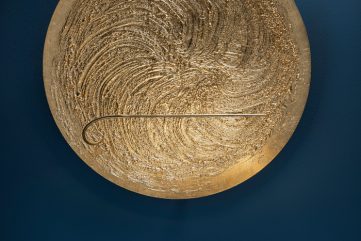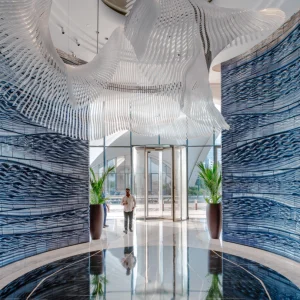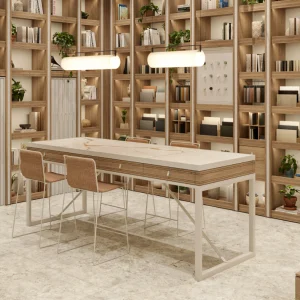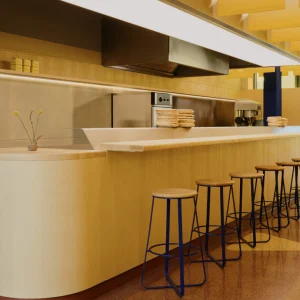
WALL LIGHTS have their place. The wall, obviously, but also a role in visually reducing the scale of a high ceiling, creating intimacy, fine-tuning an ambience or providing unobtrusive functional light (those ubiquitous snakey LED reading lights in hotel rooms).
The Bellatrix lamp from Catellani & Smith. Image Credit: Ph Nava Rapacchietta
They have a whiff of the domestic about them but that is why they translate well to leisure environments such as restaurants, and to receptions and waiting areas where they introduce a residential and therefore relaxing note.
They are occasionally eccentric bordering on bonkers – the magenta polyresin wild boar glimpsed on a net trawl is perhaps best glossed over – as the wall’s association with art is enough to tip them over into the territory between function and frivolity. Sometimes, though, they really pull off the sculptural with style. And as the following new luminaires show, they can be capable of versatility, drama and mesmirising lighting effects.
BELLATRIX
Catellani & Smith
 Image Credit: Navara Pacchietta
Image Credit: Navara Pacchietta
The use of gold leaf as a relective surface is a light motif for Catellani & Smith, experts in fully exploiting its sumptuous warmth, texture and gentle reflective qualities.
A new addition to the range is the sculptural Bellatrix lamp (named not after the Harry Potter witch, but one of the brighter stars in the Orion constellation).
A 120cm-diameter aluminium disc, Bellatrix has the typically handcrafted irregular surface lined with gold leaf. It comes in two versions: in the first, radial lines appear to be hand-drawn on the surface, while in the second the design follows centrifugal curves.
The front of the disc is illuminated by nine LED boards (1W, CRI 85) integrated into a 10mm-diameter brass rod, supported by a brass flex, allowing for adjustable lighting orientation. The interaction of the warm (2700K) indirect light with the irregular golden surface creates a striking effect. www.catellanismith.com /en
PAR 18 WALL LAMP
Catellani & Smith

Another of those luminaires where there’s more to it than meets the eye. The signature feature of the new Par 18 series, which includes the wall lamp and a chandelier, is the spherical ‘golf glass’ element, which typically plays with irregularities designed into the glass to create lit effect.

The 16cm diffuser is shaped in a mould specifically designed by Bohemian master glassmakers based on specifications and drawings by Spanish company Catellani & Smith. The specially created texture recalls a golf ball, and aims to retain the transparency of the glass while generating a distinctive interaction of light with the uneven surface of the spheres. As well as gently diffusing the light this also creates atmospheric shadow patterns on the wall or ceiling.
 Image Credit: Navara Pacchietta
Image Credit: Navara Pacchietta
A further difference with the average static wall light is that the position of the diffuser can be adjusted. The brass joint on the base allows a 350° rotation of the sphere on the horizontal axis and up to 90° on the vertical axis. The light beam can therefore be adjusted in different directions and recreate particular effects on the wall.
The lamp, which has a 9W COB LED (2700K, CRI 83), is available in two finishes, white and black, both with brass elements. www.catellanismith.com /en
ILLAN WALL
Luceplan

The Illan endures as one of the more ethereal, ingeniously simple and inspired pendant designs. Designed by Zsuzsanna Horvath for Luceplan, its very light body is made with extremely thin, flexible birch plywood, cut by laser along densely packed equidistant lines. Once suspended from the ceiling, it takes on volume and assumes its characteristic floating form.
Horvath has now designed a wall lamp version. An element of diecast aluminium is fixed to the wall and a wooden structure is then attached to the casting. The structure again comprises laser-cut layered birch plywood, extremely thin and flexible (diameter 31cm), which clads the body of the lamp and determines the characteristic geometric design.
Satisfyingly, and sustainably, the diffuser is made using surplus wood from the production of the Illan pendant, comprising the scraps from the sheet of wood used to cut out the lamp. Inside, a 21W LED source (2000K or 3000K, CRI 90) emits a soft, warm glow. The body can be installed to direct the light upward or downward. www.luceplan.com
PHASE LIGHT
Resident
 Image Credit: Toaki Okano
Image Credit: Toaki Okano
Following a collaboration that began in 2022, New Zealand company Resident has recently released the Phase lighting collection by Los Angeles-based Estudio Persona. The two Uruguayan designers, Emiliana Gonzalez and Jessie Young, characterise their work as having ‘bold silhouettes, neutral tones and raw materials free of embellishment’.
The range features a wall sconce, as well as large and small pendants, and a table light. Inspired by the phases of the moon, the luminaires are quarter circles (or ‘half moon’ for the large pendant) with a dark bronze body and warm LED-lit acrylic diffuser with a subtle linen-textured appearance.
The lumianires, handmade in New Zealand, can be arranged in multiples, offering numerous visual options. The source is a 3W LED (2700K, CRI 95). www.resident.co.nz /en
PERDUE LAMP
Lumina
 Image Credit: Pierluigi Fossa Photography
Image Credit: Pierluigi Fossa Photography
At first sight this light is perhaps a bit underwhelming until you realise how it works and how cleverly the concept is used for a whole range of options. It’s portable and rechargeable, and unusual for not being just a table lamp, generally the default option, but a whole system that includes wall lamps and pendants.
Designed by Riccardo Marcuzzo, the idea is to transform the way we experience, use and consider light, with ‘an almost infinite variety of applications and use’.

Perdue consists of an ogival-shaped lighting body – like the nose of a bullet – inside which is placed a sensor that detects a magnetic field. This turns the light on when the lamp comes into contact with its accessories (for wall, table or pendant) or with any metal body.
The light intensity can be adjusted with a simple tap on the diffuser: once will turn the lamp on at 100% power, tapping a second time dims it to 30%, a third time turns the light off. The light is warm white and high quality (3000K, CRI 90) and finishes are matt black, matt white, metallic silver, metallic champagne and metallic bronze. www.lumina.it
WALL LAMP
Tarek Dada

Wall Lamp, a lighting fixture designed by Beirut-based designer Tarek Dada, lies somewhere between art and function. It uses two distinct light sources. The first is an LED strip light that sits discreetly in the main metallic piece, casting a soft glow on the triangular plane and allowing the wall itself to become part of the piece as light interacts with different surfaces.
The second is an LED profile, concealed within a sandblasted plexiglass tube, which diffuses the light gently throughout the space, casting reflections on to its surroundings and blending the lamp into the living space.
The construction involves a steel sheet folded into an L-shape and manually etched to achieve the textured surface of the fitting. This primary piece attaches to the wall with a concealed metallic frame and supports all the other elements. A 5mm stainless steel sheet is cut into a triangular plane. Its surface is polished to a mirror-like finish and then a lacquer with selected pigments is applied to create a gradient of colours. This plane is then discreetly attached to the main metallic piece at an angle.
The intricate manipulation of light and colour also involves perforating a sheet of brushed stainless steel to create a porous surface, and oxidising a piece of brass, which is then lightly polished to produce a reflective finish. www.instagram.com / www.tarekdada www.dada-associates.com
IT IS POSSIBLE to approach Santiago Calatrava’s work from a number of perspectives: the sculptural quality of his structures; his use of the human and other natural shapes as a basis for architectural form; the movement, actual and suggested, of his buildings; the way in which he resolves into one the roles of architect, engineer and artist. However, looking through a new monograph on his work by Philip Jodidio, published by Taschen, the role that light plays is also striking.
 The UAE Pavilion showing interior lighting design. Image Credit: Barbara Burg + Oliver Schuh, Palladium Photodesign.
The UAE Pavilion showing interior lighting design. Image Credit: Barbara Burg + Oliver Schuh, Palladium Photodesign.
While architects such as Louis Kahn, Le Corbusier and Aalto, and in their footsteps Leiviskä, Holl, Liebeskind, Zumthor, Nouvel, Ando and others have always talked powerfully about the role of light in architecture, in Calatrava it is there almost as a subtext, an element so vital it is almost taken for granted.
The power of the relationship between light and architecture was certainly evident to him at an early stage of his career when he experienced some sort of epiphany in Paris.
Born in Valencia in 1951, he left Spain for Paris in 1968 with the aim (in fact unfulfilled) of studying at the École des Beaux-Arts. ‘I visited Notre Dame one morning,’ he recalls. ‘The light was streaming through the windows on the south side of the building and it was the first time I realised how sublime architecture could be, and how it can reach levels of expression that move your heart.’
Jodidio points out that Calatrava, with his structures rooted firmly in art, also traces back Le Corbusier’s famous link between light and architecture to art.
 Calatrava: Complete Works 1979-Today Author: Philip Jodidio Publisher: Taschen Multilingual edition: English, French and German ISBN: 978-3-8365-8709-9 Price: £200
Calatrava: Complete Works 1979-Today Author: Philip Jodidio Publisher: Taschen Multilingual edition: English, French and German ISBN: 978-3-8365-8709-9 Price: £200
‘When Le Corbusier wrote, “Architecture is the masterly, correct, and magnificent play of masses brought together in light” in 1923, how many people knew that he was borrowing from the thought of the sculptor Auguste Rodin?,’ he quotes Calatrava as saying. ‘In 1914, in his book Les Cathédrales de France, Rodin wrote: “The sculptor only attains great expression when he gives all his attention to the harmonic play of light and shadow, just as the architect does.” The fact that one of the most famous phrases of modern architecture was inspired not by an architect but by a sculptor underlines the significance of art.’
The following projects taken from the monograph are among those that overtly play with, manipulate and exploit light or solar energy. ‘I am always searching for more light and space,’ says Calatrava.
WORLD TRADE CENTER TRANSPORTATION HUB, NEW YORK

Complex, politically sensitive (in the middle of the Ground Zero area) and courted by controversy throughout its prolonged construction, the World Trade Center Transportation Hub nevertheless exemplifies Calatrava’s work and eventually won converts from its many dissenters.
On its opening in 2016, Brooklyn-based writer and former architect Jimmy Stamp, fully disposed to be highly critical, described it in The Guardian as ‘a light-filled cathedral of commerce and commuting’. Close up, the design was ‘confounding’, he said.
‘Light floods onto its sumptuous grey and white marble floors. It feels vast. It feels grand. It might not be the successor to Grand Central, but it is at least a descendant.’
Joseph Seymour, the former executive director of the Port Authority of New York and New Jersey, the client for the station, was positively hubristic: ‘We think he is the Da Vinci of our time,’ he said. ‘He combines light and air and structural elegance with strength.’
Calatrava lists his materials for the building as ‘glass, steel, concrete, stone and light’. Inspired by the image of a bird released from a child’s hand, the wings of the structure culminate in the oculus, which allows natural daylight to flood into the hub, filtering down through all levels eventually to the Path (Port Authority Trans-Hudson) train platform, some 20m below the street. At night, the illuminated building serves as a lantern. The building is supported by ‘columns of light’, said Calatrava.
The structure also ingeniously uses light to create a moving memorial to 9/11, by incorporating an opening roof. ‘When it retracts each 11 September, at 10.28am to mark the time of the 2001 tragedy, the orientation of the sun delivers a strip of light down below. It is the light, and the void, that deliver the message,’ he said.
OTHER PROJECTS
Planetarium (Hemisfèric), Valencia
 The 15,000m2 pavilion had 28 movable carbon-fibre composite wings powered by 46 hy-draulic actuators. Image Credit: Barbara Burg + Oliver Schuh, Palladium Photodesign
The 15,000m2 pavilion had 28 movable carbon-fibre composite wings powered by 46 hy-draulic actuators. Image Credit: Barbara Burg + Oliver Schuh, Palladium Photodesign
‘Throughout the oeuvre of Calatrava, forms are rendered more dynamic by the use of large glazed surfaces,’ says Jodidio. ‘Lit from within at night, they are the source of the continuous variation of interior lighting during the day.’
The Planetarium, an Imax theatre, was built between 1995 and 1998. It is part of Valencia’s now landmark City of Arts and Sciences, an ambitious 20-year scheme to rehabilitate a 35-hectare area on the eastern edge of the city, with all buildings – including opera house, science museum and Europe’s largest aquarium – designed by Calatrava.
The hemispheric dome with movable ribbed covering has an area of almost 2,600m2. Shaped like an eye, it can open and close like one. The glass-bottomed lake the building sits on completes the eye image with its reflection. It also enhances the Bluetooth-controlled (Casambi) RGBW lighting that takes over at nightfall, creating striking light and colour effects.
UAE Pavilion at Expo 2020, Dubai Inspired by the falcon, the national bird of the UAE, the 15,000m2 pavilion had 28 movable carbon-fibre composite wings powered by 46 hydraulic actuators. The wings protect a surface grid of photovoltaic panels in their closed position while allowing as much sunlight as possible to reach them when they are open.
 Image Credit: Planetarium (Hemisfèric), Valencia
Image Credit: Planetarium (Hemisfèric), Valencia
The lines of the interior design converge to and flow from the central 12m-diameter oculus that is 27m above the ground, bringing natural light into the exhibition spaces.
Zurich University Law Faculty
A series of seven oval reading levels are hung within the atrium, ‘staggered on each level so that it is no longer the floor area that increases as they approach the roof but the space they circumscribe’. This design allows natural light to penetrate deeper into the heart of the structure and its reading area.
ST NICHOLAS GREEK ORTHODOX CHURCH AND NATIONAL SHRINE, NEW YORK
 Image Credit: Alan Karchmer / Otto
Image Credit: Alan Karchmer / Otto
Calatrava’s watercolour sketches are an eloquent expression of his interest in light and space for the church that replaced a 19th-century building destroyed by falling debris during the 9/11 attacks. Occupying a site at 130 Liberty Street on the edge of the National September 11 Memorial park, the church is built largely from white Vermont marble. The central dome-shaped structure and a portion of the rest of the building is clad in a translucent skin that makes the building a glowing lantern at night. ‘Creating the dome out of thin stone and glass that are illuminated from within is meant to invoke the feeling of being a beacon of hope amid the night,’ said Calatrava.
He collaborated with DLR Group on the lighting design for St Nicholas Church to allow the church to read as solid stone by day, and then glow ‘by the light of 10,000 candles’ at night, balancing electric lighting with the ever-changing natural light within the church interior.
Warm (2700K) LED modules sit within a cavity between the dome’s thermal envelope and its rainscreen, made of thin sheets of Pentelic marble sandwiched between glass. The modules are precisely located with their beams directed inward to reduce shadowing of the structure on the rainscreen and to bounce illumination off the thermal envelope’s white surface, resulting in an even glow.
Daylight seeps in through apertures in the envelope, the ribs in the dome; at night, the rainscreen LEDs provide ambient indoor light through the same openings.
The dimmable interior fixtures are concealed within architectural elements such as the circular oculus (recalling the Pantheon in Rome), while discreet adjustable lighting within the cornice at the base of the dome highlights the iconography, creating the impression that light is emanating from the images themselves.
A key objective was not to overpower the natural light in the space from the oculus and apertures, the changing quality of daylight as the sun moves across the sky and clouds shift becoming integral to the interior ambience.





